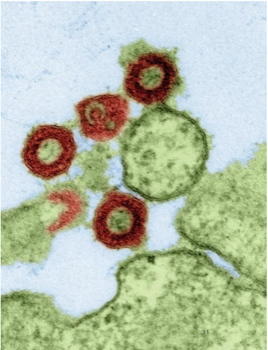Olival et al. Genomic analysis of ERVWE2 locus in patients with multiple sclerosis: absence of genetic association but potential role of human endogenous retrovirus type W elements in molecular mimicry with myelin antigen. Front Microbiol. 2013 Jun 26;4:172.
Human endogenous retroviruses (HERVs) arise from ancient infections of the host germline cells by exogenous retroviruses, constituting 8% of the human genome. Elevated level of envelope transcripts from HERVs-W has been detected in CSF, plasma and brain tissues from patients with Multiple Sclerosis (MS), most of them from Xq22.3, 15q21.3, and 6q21 chromosomes. However, since the locus Xq22.3 (ERVWE2) lack the 5' LTR promoter and the putative protein should be truncated due to a stop codon, we investigated the ERVWE2 genomic loci from 84 individuals, including MS patients with active HERV-W expression detected in PBMC. In addition, an automated search for promoter sequences in 20 kb nearby region of ERVWE2 reference sequence was performed. Several putative binding sites for cellular cofactors and enhancers were found, suggesting that transcription may occur via alternative promoters. However, ERVWE2 DNA sequencing of MS and healthy individuals revealed that all of them harbor a stop codon (a bit in the DNa that says stop making genetic message that will be made into a protein) at site 39, undermining the expression of a full-length protein. Finally, since plaque formation in central nervous system (CNS) of MS patients is attributed to immunological mechanisms triggered by autoimmune attack against myelin (Not according to DoctorCryAb), we also investigated the level of similarity between envelope protein and myelin oligodendrocyte glycoprotein (MOG). Comparison of the MOG to the envelope identified five retroviral regions similar to the Ig-like domain of MOG. Interestingly, one of them includes T and B cell epitopes, capable to induce T effector functions and circulating Abs in rats. In sum, although no DNA substitutions that would link ERVWE2 to the MS pathogeny was found, the similarity between the envelope protein to MOG extends the idea that ERVEW2 may be involved on the immunopathogenesis of MS, maybe facilitating the MOG recognizing by the immune system. Although awaiting experimental evidences, the data presented here may expand the scope of the endogenous retroviruses involvement on MS pathogenesis.
This is a tenuous link. This endogenous virus will not make a proper protein but in the sequence there is something that looks like myelin oligodendrocyte glycoprotein that may allow there to be a molecular mimicry so this could be an autoimmune trigger. However, not many MSers respond to MOG and why not do comparison with other myelin and non-myelin proteins? The thing to read is "No DNA substitutions that would link ERVWE2 to the MS pathogeny was found". Prof G likes the viral hypothesis.
